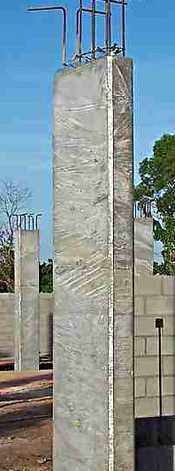
EN 1992
Encyclopedia

Concrete
Concrete is a composite construction material, composed of cement and other cementitious materials such as fly ash and slag cement, aggregate , water and chemical admixtures.The word concrete comes from the Latin word...
structure
Structure
Structure is a fundamental, tangible or intangible notion referring to the recognition, observation, nature, and permanence of patterns and relationships of entities. This notion may itself be an object, such as a built structure, or an attribute, such as the structure of society...
s, using the limit state design
Limit state design
Limit state design refers to a design method used in structural engineering. A limit state is a condition of a structure beyond which it no longer fulfills the relevant design criteria. The condition may refer to a degree of loading or other actions on the structure, while the criteria refers to...
philosophy. It was approved by the European Committee for Standardization
European Committee for Standardization
The European Committee for Standardization or Comité Européen de Normalisation , is a non-profit organisation whose mission is to foster the European economy in global trading, the welfare of European citizens and the environment by providing an efficient infrastructure to interested parties for...
(CEN) on 16 April 2004.
Eurocode 2 is subdivided into the following parts:
EN 1992-1-1: General rules, and rules for buildings
- General
- Basis of design
- Materials (concrete and steelSteelSteel is an alloy that consists mostly of iron and has a carbon content between 0.2% and 2.1% by weight, depending on the grade. Carbon is the most common alloying material for iron, but various other alloying elements are used, such as manganese, chromium, vanadium, and tungsten...
) including- Concrete
- Reinforcing steel
- Prestressing steel
- Durability and cover to reinforcement
- Structural analysis
- Ultimate limit states
- Serviceability limit states
- Detailing reinforcementReinforced concreteReinforced concrete is concrete in which reinforcement bars , reinforcement grids, plates or fibers have been incorporated to strengthen the concrete in tension. It was invented by French gardener Joseph Monier in 1849 and patented in 1867. The term Ferro Concrete refers only to concrete that is...
and prestressing tendons - Detailing members, and particular rules
- Precast elements - additional rules
- Lightweight aggregatedConstruction AggregateConstruction aggregate, or simply "aggregate", is a broad category of coarse particulate material used in construction, including sand, gravel, crushed stone, slag, recycled concrete and geosynthetic aggregates. Aggregates are the most mined material in the world...
concrete structures - Plain and lightly reinforced concrete structures

